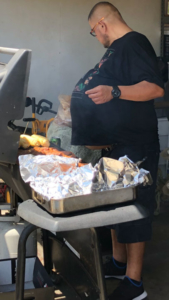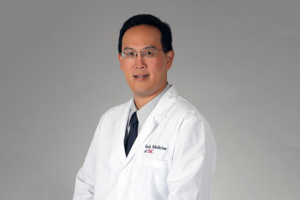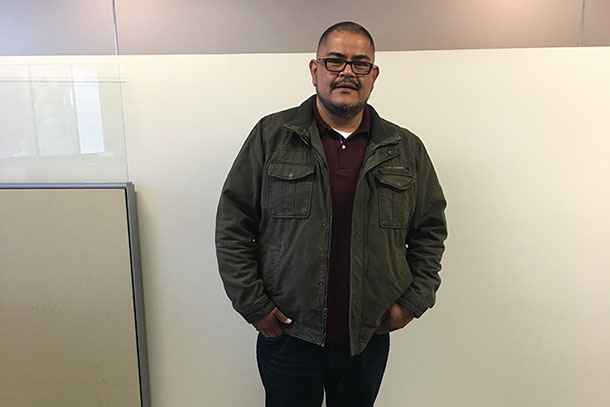William Tseng, MD, an internationally recognized sarcoma expert and associate professor of clinical surgery at the Keck School of Medicine of USC, knew he wanted to be a cancer surgeon back when he was in high school and participated in a summer research program at City of Hope.
“I was able to shadow some of the cancer surgeons. I thought it was a perfect combination of the technical parts of surgery and knowing about the disease – the research parts,” Tseng recalled. He used his temporary City of Hope e-mail account to write the chairman of the department of surgery there and asked if he could observe an operation. He was shocked to get a reply back: Yes, he could. “I was more excited than nervous,” he said. The budding surgeon was on his way.
Several years later, when Tseng entered his surgical oncology fellowship at MD Anderson Cancer Center in Houston, he at first intended to specialize in pancreatic cancer, but he soon found that it was sarcoma that really captured his interest.
“Sarcoma is a complex disease,” Tseng explained. “There are 50–70 different subtypes, each unique, and they can develop anywhere in the body. Because it is so complex, you want to make sure you see a sarcoma specialist who has in-depth knowledge of the disease. I was also fascinated because on top of that, it’s a very rare disease, so it doesn’t get a lot of attention. Sarcomas make up just 1 percent of cancers in adults.”
In fact, it’s so rare that cases often cause a bit of commotion when the public learns about them. Back in February, Tseng was amused to see a New Jersey man who had a 30-pound tumor removed featured on the Today show. This was described as a “once-in-a-career” event for most physicians, which is generally true; however, Tseng removes a tumor of that size about every other week.

Hector Hernandez often was teased about his “beer belly” before doctors diagnosed him with retroperitoneal liposarcoma. (Photo/Courtesy Hector Hernandez)
Tseng removed the largest tumor he’s encountered to date this July. The patient, Hector Hernandez, didn’t realize he had a rare cancer. His friends teased him about his “beer belly,” even though Hernandez didn’t drink beer, and his stomach and overall weight didn’t seem to respond to exercising, even though Hernandez’s arms were getting thinner. His stomach was also hard to the touch. With a little prodding from his family, Hernandez finally went to see his doctor, who diagnosed a retroperitoneal liposarcoma, a cancer that starts in the fat cells at the back of the abdomen — and one of Tseng’s special areas of expertise.
Hernandez’s operation illustrated many of the complicated, layered decisions involved in sarcoma surgery. “It’s standard in surgical oncology to take a cancerous mass out whole, but a large tumor will almost certainly be in contact with other important organs and sometimes major blood vessels. The question then becomes whether these also need to be removed.
“You’re working all the way around and on either side of the tumor,” Tseng explained. “You really have to think about the disease, what adjacent organs or vessels you can remove safely and what is best for the patient in terms of long term outcomes and quality of life.”
After a six-hour operation, Tseng had removed a 77-pound tumor from Hernandez — roughly the weight of an average 10-year-old boy.
“It was very gratifying to see his before and after photos and see him back at the size he was four or five years ago,” Tseng said. “To be able to take it out safely and see him enjoy a good quality of life after, that’s a big thing.”
Tseng also sees patients with sarcomas in other parts of the body such as legs, arms and torso, but what unifies the care in these cases is collaboration with other physicians. “You work closely with a team of other physician specialists. A medical oncologist, for example, might recommend chemotherapy first to shrink the tumor before surgery. Or a radiation oncologist may feel there is a benefit to giving radiation therapy after surgery. You decide together on the appropriateness of a therapy and the timing of it in relation to other treatments. Effective treatment of sarcoma isn’t just about simply cutting it out. That teamwork is part of what drew me to sarcoma in the first place.”

William Tseng
When Tseng isn’t working with patients, he enjoys modern art and tries to combine his interests by going to an art museum whenever he travels to a new city to attend a conference or work with collaborators.
“I love modern art, because it shows so much about the personality of the artist and the way of thinking at the time. I love to analyze a piece from my standpoint and try to figure out what the artist wanted to say before I read any of the text that accompanies it,” he said.
But his favorite thing to do for fun is just hang out with his family, including his wife, their 15-month-old son and their Jack Russell terrier-Chihuahua mix “fur son.”
“Spending time with them is what I value the most,” Tseng said.
— Lex Davis


